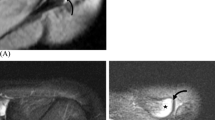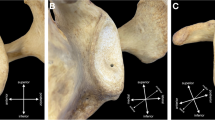Abstract
Objective
To assess the MRI appearance of normal skeletal development of the glenoid and glenoid–coracoid interface in the pediatric population. To the best of our knowledge, this has not yet been studied in detail in the literature.
Materials and methods
An IRB-approved, HIPAA-compliant retrospective review of 105 consecutive shoulder MRI studies in children, ages 2 months to 18 years was performed. The morphology, MR signal, and development of the following were assessed: (1) scapular-coracoid bipolar growth plate, (2) glenoid and glenoid–coracoid interface secondary ossification centers, (3) glenoid advancing osseous surface.
Results
The glenoid and glenoid–coracoid interface were identified in infancy as a contiguous, cartilaginous mass. A subcoracoid secondary ossification center in the superior glenoid was identified and fused in all by age 12 and 16, respectively. In ten studies, additional secondary ossification centers were identified in the inferior two-thirds of the glenoid. The initial concavity of the glenoid osseous surface gradually transformed to convexity, matching the convex glenoid articular surface. The glenoid growth plate fused by 16 years of age. Our study, based on MRI, demonstrated a similar pattern of development of the glenoid and glenoid coracoid interface to previously reported anatomic and radiographic studies, except for an earlier development and fusion of the secondary ossification centers of the inferior glenoid.
Conclusions
The pattern of skeletal development of the glenoid and glenoid–coracoid interface follows a chronological order, which can serve as a guideline when interpreting MRI studies in children.








Similar content being viewed by others
References
Cardoso HF. Age estimation of adolescent and young adult male and female skeletons II, epiphyseal union at the upper limb and scapular girdle in a modern Portuguese skeletal sample. Am J Phys Anthropol. 2008;137(1):97–105.
Chapman VM, Nimkin K, Jaramillo D. The pre-ossification center: normal CT and MRI findings in the trochlea. Skeletal Radiol. 2004;33(12):725–7.
Chauvin NA, Jaimes C, Laor T, Jaramillo D. Magnetic resonance imaging of the pediatric shoulder. Magn Reson Imaging Clin N Am. 2012;20(3):327–47.
Chung T, Jaramillo D. Normal maturing distal tibia and fibula: changes with age at MR imaging. Radiology. 1995;194(1):227–32.
Ecklund K, Jaramillo D. Imaging of growth disturbance in children. Radiol Clin North Am. 2001;39(4):823–41.
Jaimes C, Jimenez M, Marin D, Ho-Fung V, Jaramillo D. The trochlear pre-ossification center: a normal developmental stage and potential pitfall on MR images. Pediatr Radiol. 2012;42(11):1364–71.
Jans LB, Jaremko JL, Ditchfield M, Verstraete KL. Evolution of femoral condylar ossification at MR imaging: frequency and patient age distribution. Radiology. 2011;258(3):880–8.
Jaramillo D, Waters PM. MR imaging of the normal developmental anatomy of the elbow. Magn Reson Imaging Clin N Am. 1997;5(3):501–13.
Kim HK, Emery KH, Salisbury SR. Bare spot of the glenoid fossa in children: incidence and MRI features. Pediatr Radiol. 2010;40(7):1190–6.
Kwong S, Kothary S, Poncinelli L. Skeletal development of the proximal humerus in the pediatric population: MRI features. AJR. 2014;202(2):418–25.
Laor T, Jaramillo D. MR Imaging insights into skeletal maturation: what is normal? Radiology. 2009;250(1):28–38.
Ly JQ, Bui-Mansfield LT, Kline MJ, DeBerardino TM, Taylor DC. Bare area of the glenoid: magnetic resonance appearance with arthroscopic correlation. J Comput Assist Tomogr. 2004;28(2):229–32.
Mao JJ, Nah HD. Growth and development: hereditary and mechanical modulations. Am J Orthod Dentofacial Orthop. 2004;125(6):676–89.
Ogden JA, Phillips SB. Radiology of postnatal skeletal development. VII. The scapula. Skeletal Radiol. 1983;9(3):157–69.
Scheuer L, Black S. “The pectoral girdle.” Developmental juvenile osteology. San Diego, CA: Elsevier Academic Press, 2000. 252–271. Print.
Varich LJ, Laor T, Jaramillo D. Normal maturation of the distal femoral epiphyseal cartilage: age-related changes at MR imaging. Radiology. 2000;214(3):705–9.
Villemure I, Stokes IA. Growth plate mechanics and mechanobiology. A survey of present understanding. J Biomech. 2009;42(12):1793–803.
Zawin J, Jaramillo D. Conversion of bone marrow in the humerus, sternum, and clavicle: changes with age on MR images. Radiology. 1993;188(1):159–64.
Conflict of interest
The authors declare that they have no conflicts of interest.
Author information
Authors and Affiliations
Corresponding author
Rights and permissions
About this article
Cite this article
Kothary, S., Rosenberg, Z.S., Poncinelli, L.L. et al. Skeletal development of the glenoid and glenoid–coracoid interface in the pediatric population: MRI features. Skeletal Radiol 43, 1281–1288 (2014). https://doi.org/10.1007/s00256-014-1936-0
Received:
Revised:
Accepted:
Published:
Issue Date:
DOI: https://doi.org/10.1007/s00256-014-1936-0




